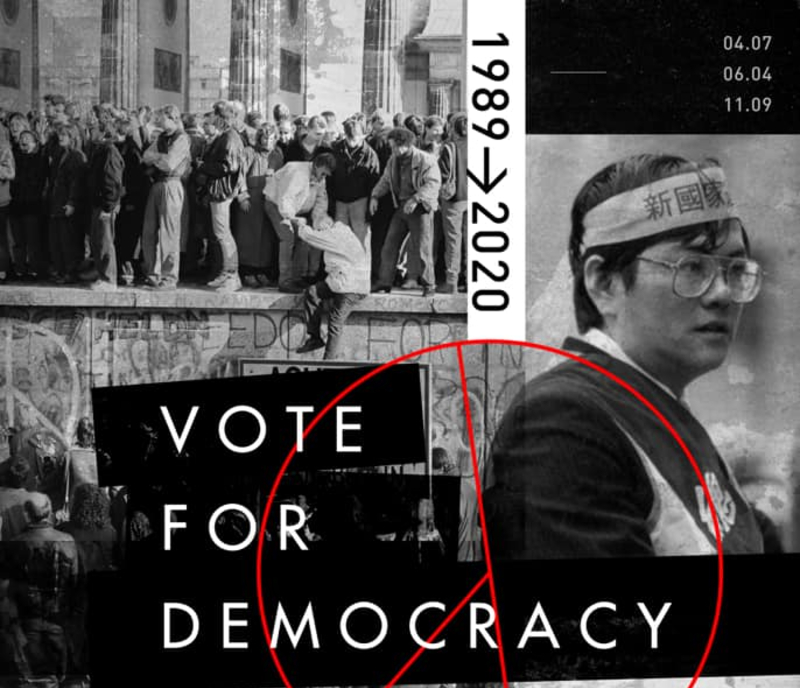Taiwan’s presidential election will take place on January 11, 2020, and, in order to encourage participation, Taiwanese netizens have started a poster design challenge [2] through the hashtag #GraphicDesignForDemocracy.
Through the posters, people can take a closer look into the country's political history and the significance of democracy for Taiwanese people who lived under martial law (1949-1987) and white terror (1947-1990) for more than 40 years under the Kuomingtang-led government of the Republic of China (ROC), which fled to the island of Taiwan after it was defeated in 1949 by the Chinese Communist Party (CCP) in the Chinese Civil War [3].
The Taiwanese only gained their right to vote for Legislative Yuan in 1992 and for president in 1996 after decades of struggle under military dictatorship.
The 2020 presidential seat will be contested by incumbent president Tsai Ing-wen, of the Democratic Progressive Party (DPP), who is running for a second term, and Han Kuo-yu of the Kuomingtang (KMT), who sees the controversial One-China Consensus [4] favorably.
The organizers began releasing the submitted posters on 22 of December. Below are five posters that reflect the Taiwanese's aspirations for democracy.
Vote for democracy, by Fan Gang-Hsin (范綱燊)
Fan's poster [5] is a collage of photos from 1989, a year marked by mass protests in favor of democracy. The designer was born in 1989.
Fan attached an explainer to his poster:
1989年出生的你我,今年30歲。
那年,世界的民主自由浪潮開啟了新的一頁。
1989.04.07
我們的鄭南榕前輩,為了爭取百分之百的言論自由,遭到國民黨侯友宜警官圍困在雜誌社內,最後拒捕自焚明志。同年,義士詹益樺用同樣的方式,追隨了南榕前輩的身影。
1989.06.04
在中國,數以萬計的人民於天安門廣場和平集會,爭取與政府對話,期望能有更開放自由的社會。卻被步槍子彈坦克刺刀無情輾碎。
1989.11.09
阻擋人民投奔自由的柏林圍牆倒塌,東歐民主化浪潮席捲而來。冷戰結束,蘇聯解體。世界開始迎來新的一波民主改革。
時至今日,
我們的民主還不成熟,還很脆弱。
敵人不再是槍砲坦克,變成了謊言、欺騙、操弄分化一再傷害我們得來不易的今天。而我們手中的每一張選票,都是我們對抗反民主自由者最大的武器。
2020.01.11 — Go VOTE
You and I were born in 1989. And this year we turned 30.
The year marks a new page for the world's struggle for freedom and democracy.
April 7, 1989
Our forerunner Cheng Nan-jung [7] set himself on fire as the police attempted to break in his newsroom office to arrest him. He sacrificed his life for freedom of speech. On the same year, Chan I-hua [8] followed his footstep.
June 4, 1989 [9]
In China, thousands of people gathered at Tiananmen Square demanding a more open and free society. But they were repressed by tanks and guns.
November 9, 1989
The Berlin Wall, which blocked people from seeking freedom, has fallen. A new wave of democratic movements started in Eastern Europe. The Cold War ended and the Soviet Union disintegrated. It opened up a new page of democratic reform in the world.
Today, our democracy is not yet mature, it is still very fragile.
The enemy is not using guns or tanks, but lies and manipulation to divide us, to hurt what we had struggled for. Our vote is the strongest weapon to resist against the enemy of freedom and democracy.
2020.01.11- go vote.
2. Vote for Hope, by Lin Pin-Hsien
For Lin, the ballot is like the pole star that brings hope:
Here is the designer's message:
希望,從來不應該是以歧視謾罵,低俗的話語為出發點,也不該被亂用淪為信口開河,滿口胡言的代名詞。希望是不論在怎樣艱難與不安的情況下,永遠指引我們方向的北極星。希望是儘管面臨強大的挑戰與壓力之下,確保我們依然能以良知來行動的指標。真正的希望,從來就不能輕易得到,但現在,我們能用一種簡單的方式去爭取。
Hope has nothing to do with smearing and should not be used as an empty political rhetoric. Hope is the pole star that guides us through difficulties and distress. It is the conscience that helps us to make difficult choices. Hope is precious, but now what we need to do is simple.
Vote for Taiwan, by Shi Su (石蘇)
Shi Su's poster includes tens of thousands of words gathered from news reports on significant political incidents in Taiwan’s struggle for democracy since 1947.
Among the news reports Shi Su picked are:
The “228 incident [12]” which took place on February 28, 1947. A Tobacco Monopoly Bureau enforcement team in Taipei violently confiscated smuggled cigarettes from a 40-year-old widow. The incident triggered a protest and a brutal crackdown which led to the death of thousands of civilians and the beginning of the “white terror [13]” era.
The “Zhongli incident [14]” which took place on 26 of November 1977. Ten thousand people protested against local election fraud which resulted in police repression.
The Formosa Magazine crackdown or the Kaohsiung Incident [15] of December 10, 1979, when the KMT's military troop charged protesters who rallied to commemorate the International Human Rights Day.
The “May 19 Green Action [16]” in 1986, which was the beginning of a movement calling for an end to martial law in Taiwan.
The “Taoyuan airport incident [17]“, when thousands of DDP supporters gathered at the airport to welcome the return of opposition political leader Hsu Hsin-liang to Taiwan after years of exile.
The “Wild Lily student movement [18]” from March 16 to 22 in 1990, when tens of thousand students gathered at the Liberty Square in Taipei demanding universal suffrage of the country's president and vice president.
The first presidential election on March 23, 1996.
Train back home or to the concentration camp? By Anmy Shine
As many of the voters have to travel back to their hometown to vote, Anmy Shine used the high-speed train as the background of her poster.
The designer further suggested that the voter's ballot is a choice between protection of their homeland or giving in to China's authoritarian model:
乘上回家投票的車
或送往集中營的列車
A train for you to return home to vote
Or a train to bring you to concentration camp
KMT signed the One-China Consensus [4] with China in 1992 and Chinese President Xi Jinping has repeatedly stressed that Hong Kong's One Country Two Systems model [20] would be applied to Taiwan.
You can’t eat freedom, by Yun Zon Zen
“What's the use of freedom? It is not rice and can't be eaten!” This is a common saying among the elderly in Chinese society as they view stability and prosperity as more important than democracy and freedom. Yun Zon Zen asserts that freedom can't be eaten with a rice bowl and stresses that the bowl can protect people from the swine flu, organ harvesting [22], patriotic education, and re-education camps.





